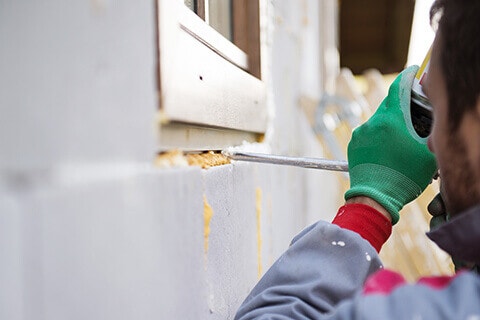Drafty Windows: Causes & Tips
Posted
on December 4, 2016

As the outside temperatures drop, your warm home becomes a haven from cold or below-normal temperatures. But when you notice a cool breeze when you’re indoors, you may need to seek out the potential causes and see what you can do to help keep your home warm and comfortable.
How to identify the source of a draft
One way you can identify the source of drafts is pretty low-tech. It involves a candle or a stick of incense. Very carefully hold a candle or incense near where you noticed the draft. Once you trace the cool air movement to the source, mark it with a sticky note to remember the spot.
There are other, more technical ways that professionals can help identify the source of a draft. If you are struggling to find where the cool air is entering your home, it may be smart to seek some professional help.
Is a draft a sign of window issues?
Not necessarily. And the cool air your feeling may be the result of a natural part of the environment when air moves across the cold glass of a window rather than a draft through windows themselves. Here are a few tips for determining whether your window or the area around your window has a draft.

Determine the cause of a draft:
First, check to ensure your window is properly closed and locked. On warm days we may open windows to let in a little fresh air, then forget to re-seal them when the weather turns cool quickly. A best practice for windows (regardless of brand or type) is to have windows closed and locked when not being used to let in the fresh air on a nice day. Check the seal, locks, and operation of your window to make sure they are closing and performing as intended.
Next, consider a few questions to help you determine whether your window is displaying issues, or simply showing it’s age.
How old is your window? Window technology has changed over the years and single-pane windows or older windows may have worn weather seals, or may be lacking the additional insulation properties that newer windows have (such as multiple panes of glass, insulating gasses between the panes of glass, etc.).
If you have single pane windows, are storm windows installed? A storm window may offer some protection against elements.
Was your window professionally installed? It might be tempting to DIY a window install to save some cash, but installing windows can be tricky business and getting it right takes experience and knowledge. A windows performance is only as good as its installation.


If you determine the draft is not coming from the window itself, check for drafts around the window. If that is not the source, check any unsealed wall leaks which could potentially include things like light fixtures, outlets, exhaust fans, pipe penetrations - to determine if the cooler air is coming from there. Use these guidelines from the Department of Energy on how to use caulk to seal air leaks.
If you’re unsuccessful determining the source of the draft, or you just want some additional advice, consider a home energy audit. Some local utility companies offer services including things like home energy audits or thermal imaging. Check with your utility company to see what may be offered.
Tips for reducing the impact of drafts
If you’ve taken steps to help improve or address the drafts but still find yourself reaching for the thermostat when you feel cool air, consider these tips to lessen the impact.
Try adding curtains to help reduce the window and air currents that can impact the comfort of your home. Not all window treatments are created equal - certain heavier fabrics or layered curtains may help lessen drafts better than others. Honeycomb shades can trap air between layers to help provide insulation. According to energy.gov, when drawn during cold weather, most conventional draperies can reduce heat loss from a warm room up to 10%.
Rearranging your furniture may help as well. Consider arranging seating to face your windows so you can look out, rather than next to your windows. This allows for improved comfort and a great view.
Looking for professional help? Contact the pros at Pella for help. With an in-home consultation you can get expert advice on your current windows and help determining whether window replacement is a good fit for your home.
Schedule a free consultation to find windows and doors for your home.
